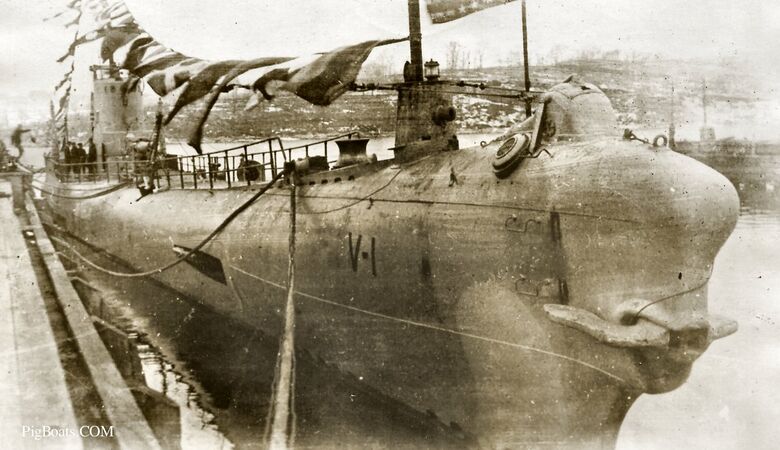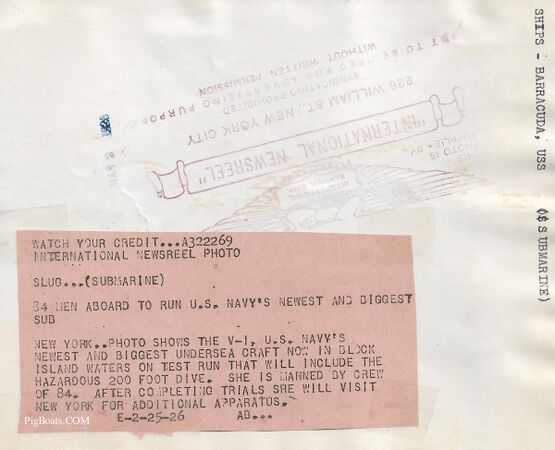V-1: Difference between revisions
Pbcjohnston (talk | contribs) Added photos |
Pbcjohnston (talk | contribs) |
||
| (17 intermediate revisions by 2 users not shown) | |||
| Line 1: | Line 1: | ||
[[File:Header | {{#seo:|title=submarine USS V-1 Barracuda (SS-163) - PigBoats.COM submarine|title_mode=replace}} | ||
{{#seo:|description=Photographs and pictures of the submarine USS V-1 Barracuda (SS-163)}} | |||
[[File:New Header V-1 class.jpg]]<br> | |||
__TOC__ | |||
== Construction and Sea Trials, 1924 == | |||
[[File:Barracuda prelaunch 1.jpg|left|500px]] | [[File:Barracuda prelaunch 1.jpg|left|500px]] | ||
<div style="text-align: justify;"><span style="color:#00008B">Pre-launch photo of the bow of the V-1, taken on July 16, 1924 at Portsmouth Navy Yard. The sub has been decked out with bunting and signal flags for her launch the next day. | <div style="text-align: justify;"><span style="color:#00008B">Pre-launch photo of the bow of the V-1, taken on July 16, 1924 at Portsmouth Navy Yard. The sub has been decked out with bunting and signal flags for her launch the next day. | ||
This is a good look of the bow torpedo tube outer doors. Unlike subsequent practice, they do not smoothly fare into the outer hull. The pressure hull was a complex of various angles and diameters bringing the torpedo tubes to the hull's lowest point. The hull was a variety of shapes from circular to ellipses, making the construction | This is a good look of the bow torpedo tube outer doors. Unlike subsequent practice, they do not smoothly fare into the outer hull. The pressure hull was a complex of various angles and diameters bringing the torpedo tubes to the hull's lowest point. The hull was a variety of shapes from circular to ellipses, making the construction very difficult for the shipyard. | ||
<small>U.S. Navy photo</small> | <small>U.S. Navy photo</small> | ||
| Line 24: | Line 33: | ||
<small>Photo in the private collection of Ric Hedman.</small> | <small>Photo in the private collection of Ric Hedman.</small> | ||
[[File:Red bar sub new.jpg]] | |||
[[File:V-1 under construction.jpg|left|500px]] | |||
V-1 alongside the fitting out pier at the Portsmouth Navy Yard, Kittery, Maine. The date is late summer 1924 and there is still a lot of work to do to complete her construction phase and get her ready for sea trials. The big fleet boat dwarfed any submarine previously built at Portsmouth, presenting special challenges to the yard workers. | |||
<small>USN photo in the private collection of Ric Hedman.</small> | |||
[[File:Red bar sub new.jpg]] | [[File:Red bar sub new.jpg]] | ||
| Line 40: | Line 56: | ||
[[File:Red bar sub new.jpg]] | [[File:Red bar sub new.jpg]] | ||
[[File:V-1 early photo from starboard USN 456143.jpg|left|500px]] | |||
V-1 underway at a sedate pace in the Atlantic, likely during her initial sea trials in November, 1924. The location is likely between the New Hampshire coast and the [https://en.wikipedia.org/wiki/Isles_of_Shoals '''Isle of Shoals'''], a frequent submarine operating area in those days. The authors have not been able to determine if the discoloration on her amidships and aft superstructure is corrosion related or is simply an artifact of the photograph. The two photographs above seem to indicate that the yard had not yet fully applied the required haze-gray paint scheme to the boat when she departed on trials, and this is not entirely unusual during this period. | |||
At least 13 men are topside, and these would have been a combination of the sub's crew, and civilian yard workers aboard to test and observe the installed systems. Her heavy fore to aft mine clearance wires and long range aerial wires have not yet been installed. There is no smoke from the aft engines, indicating that she is running with them disengaged, powered by the forward generator engines or just running on the battery. | |||
<small>Photo USN 456143 courtesy of NHHC.</small> | |||
[[File:Red bar sub new.jpg]] | |||
<div style="text-align: justify;"><span style="color:#000000"> | |||
== Operational service as V-1, 1924 to 1931 == | |||
[[File:Barracuda Washington Navy Yard-2.jpg|left|500px]] | [[File:Barracuda Washington Navy Yard-2.jpg|left|500px]] | ||
| Line 58: | Line 87: | ||
[[File:Barracuda Washington Navy Yard-1.jpg|left|500px]] | [[File:Barracuda Washington Navy Yard-1.jpg|left|500px]] | ||
<div style="text-align: justify;"><span style="color:#00008B">A third view of the | <div style="text-align: justify;"><span style="color:#00008B">A third view of the V-1 and although it is dated the same as the two photos above the lack of the ship in the background indicates that it was likely taken several hours after the other two. | ||
<small>U.S. Navy photo</small> | <small>U.S. Navy photo</small> | ||
| Line 74: | Line 103: | ||
<div style="text-align: justify;"><span style="color:#00008B">V-1 running close ashore to Block Island, approximately January, 1925. The trees are bare and there is lots of ice slurry on the calm waters. This shakedown cruise was intended to fully test the Busch-Sulzer 6M375 diesel engines and would range as far as the Caribbean. She did not return to Portsmouth until the end of May. | <div style="text-align: justify;"><span style="color:#00008B">V-1 running close ashore to Block Island, approximately January, 1925. The trees are bare and there is lots of ice slurry on the calm waters. This shakedown cruise was intended to fully test the Busch-Sulzer 6M375 diesel engines and would range as far as the Caribbean. She did not return to Portsmouth until the end of May. | ||
All three of her radio masts are lowered, indicating that she has just surfaced or is preparing to dive, although either maneuver would be dangerous this close to land. | |||
<center>[[File:RWB_starbar.jpg]]</center> | |||
It was reported in The Evening Leader of Corning, NY on Feb 20, 1925 the following: ''"Faizalli Mahrshacca. 20. Lascar¹ fireman in the British steamer Luceric, which came into Norfolk, Va., recently, had been denied shore leave and was determined to land in America. So when the ship was passing Thimble Shoals he threw a keg overboard and jumped after it, clinging to it through the chilly dawn. The submarine B-1² was proceeding down the harbor and sighted the Lascar, still clinging to his keg. He was almost frozen, but he fought against rescue and was subdued by force. The submarine carried the man to Cape Henry and placed him aboard the pilot boat Relief, which hastened to overtake the Luceric, and put the man back aboard her as she passed through the Virginia Capes"'' | |||
<small>'''1'''. Lascar; A semi-derogatory term for a sailor or militiaman from the Indian subcontinent, Southeast Asia, the Arab world, British Somaliland or other lands east of the Cape of Good Hope who was employed on European ships from the 16th century until the mid-20th century.<br> | |||
'''2'''. Referring to this boat as B-1 was likely a simple typo at the time by the reporter. V-1's name was changed to Barracuda on February 19, 1931 and between then and late 1938 she coincidentally had the class identifier "B-1" painted on the side of her fairwater, but this was not the boat's name. It certainly was not being used in 1925 when the article was written. [https://pigboats.com/images/b/b2/Submarine_names_2.pdf '''See this article'''] for more information on this confusing issue.</small> | |||
<small>National Archives photo</small> | <small>National Archives photo</small> | ||
| Line 82: | Line 118: | ||
One of the two ship's boats, stowed under the deck just aft of the conning tower fairwater when not in use, can be seen moored alongside. Forward of the conning tower can be seen a folding set of steps to allow access to the submarine from a small boat. These were folded back into the superstructure when not needed. | One of the two ship's boats, stowed under the deck just aft of the conning tower fairwater when not in use, can be seen moored alongside. Forward of the conning tower can be seen a folding set of steps to allow access to the submarine from a small boat. These were folded back into the superstructure when not needed. | ||
<small>Photo in the private collection of Ric Hedman.</small> | |||
[[File:Red bar sub new.jpg]] | |||
<gallery mode="packed" widths="400px" heights="300px"> | |||
File:V-1 2-25-26 flags front.jpg | |||
File:V-1 2-25-26 flags back.jpg | |||
</gallery> | |||
</center> | |||
<br> | |||
<div style="text-align: justify;"><span style="color:#00008B">These two images show the front and back of a photo of V-1 on February 26, 1926 while undergoing tests in New England waters. The location is a snowy, cold, and breezy Submarine Base New London, CT. She would soon head out out into Block Island Sound and the Atlantic to run tests. A stiff breeze is blowing, judging by the heavily waving flags. | |||
<center>[[File:RWB_starbar.jpg]]</center> | |||
It was reported on April 30, 1926 that the V-1, while under command of LCDR [[Picking|'''Sherwood Picking''']], struck a large whale while submerged off Cape Cod. The submarine was in the act of surfacing when a sudden jolt shook the submarine. Upon surfacing a 58 foot long whale was found to be bent around the bow of the submarine. The collision had apparently broken the whale's back and killed it. The sub suffered no damage. The whale was towed into Provincetown before being towed back to sea and allowed to sink. | |||
<small>International Newsreel photo in the private collection of Ric Hedman.</small> | |||
[[File:Red bar sub new.jpg]] | |||
[[File:V-1 on trials NH 63175.jpg|left|500px]] | |||
V-1 running with a "full head of steam" during engineering trials following an overhaul period, June 5, 1926. The location is the New England coast, either near the Isle of Shoals off the New Hampshire coast, or in Cape Cod Bay on the measured mile there. She is throwing up a substantial bow wake in the calm waters and her aft main propulsion engines are smoking considerably, meaning that they are under a heavy load. To get this speed she would also have to have her forward generator engines engaged and under load, producing extra electricity for the main motors. She is likely near her top speed of 21 knots, but it is known that the [[V-1 Class|'''V-1 class boats''']] struggled to achieve and maintain this high pace. | |||
Her three radio masts (forward, fairwater, and aft) are fully raised with the long-line radio aerials strung between them. This enabled the sending and reception of messages at long range, an essential element of her mission as a scout for the fleet. | |||
<small>Photo NH 63175 courtesy of NHHC.</small> | |||
[[File:Red bar sub new.jpg]] | |||
[[File:V-1 San Diego 1925-1928.jpg|left|500px]] | |||
V-1 shown underway off an unknown location, possibly San Diego, 1925-1928. At the time of this photo, she still has her large 5"/51 caliber gun on the forward deck. This gun was removed in mid-1928 and replaced with a smaller 3"/50 caliber gun as a weight saving measure. The gun itself is trained out to port, indicating that they may have recently participated in a gunnery exercise. A number of the crew are lounging on the deck aft of the fairwater, atop the small boat stowage locker with their feet hanging over the boat boom crane. These boats still did not have air conditioning at this point, and thus were hot and stuffy below decks. The crew were afforded many opportunities to come topside in order to escape the sometimes fetid conditions below. | |||
There is a slight roll to the seas, with the boat on top of one wave with water draining from the superstructure. | |||
<small>Photo in the private collection of Dave Johnston.</small> | |||
[[File:Red bar sub new.jpg]] | |||
[[File:Barracuda Panama canal.jpg|left|500px]] | |||
<div style="text-align: justify;"><span style="color:#00008B">V-1 transiting the Gaillard Cut in the Panama Canal, November, 1927. The steep sides of the cut in these early days are evident in this photo. | |||
<small>Photo in the private collection of Ric Hedman.</small> | <small>Photo in the private collection of Ric Hedman.</small> | ||
| Line 101: | Line 176: | ||
[[File:Red bar sub new.jpg]] | [[File:Red bar sub new.jpg]] | ||
[[File:Barracuda pearl harbor1928-1.jpg|left|500px]] | |||
<div style="text-align: justify;"><span style="color:#00008B">The crew of the V-1 photographed at Pearl Harbor sometime between the end of April, 1928 and mid-June, 1928. She came to Hawaii to take part in Fleet Problem VIII, an exercise that pitted light cruisers and a detachment of ships from Pearl Harbor ("Orange") against the Battle Fleet and the supply Train ("Blue"). The Submarine Division 20 tender seen alongside is the USS Argonne (AS-10). | |||
In the photo the fourth man from the left, second row from the top, is Herman S. 'Brigham' Young, grandfather of Johanna Young who submitted this photo. | |||
The barrel of the V-1's 5"/51 caliber deck gun is pointed to the right in the photo to make room for all the men to be positioned at the widest point on the deck. The top man on the right is leaning on the barrel. | |||
<small>Original photo in the family collection of Johanna Young. MAY NOT BE REUSED OR REPOSTED WITHOUT PERMISSION.</small> | |||
[[File:Red bar sub new.jpg]] | |||
<div style="text-align: justify;"><span style="color:#000000"> | |||
== Renaming and later service, 1931 to 1945 == | |||
[[File:barracuda juneau-1.jpg|left|500px]] | |||
<div style="text-align: justify;"><span style="color:#00008B">V-1 was renamed Barracuda on February 19, 1931 and a few months later was redesignated SS-163. The summer of 1934 had her and her sisters conducting a cruise to Alaska, and Barracuda is seen here anchored in Juneau, July, 1934. By this time her deck gun had been changed out for a 3"/50 caliber Mk 17 gun. The lighter weight weapon helped to improve stability problems of the class. | |||
<small>Photo in the private collection of Ric Hedman.</small> | |||
[[File:Red bar sub new.jpg]] | |||
[[File:Barracuda juneau-2.jpg|left|500px]] | |||
<div style="text-align: justify;"><span style="color:#00008B">Barracuda is moored to one of her sisters in an Alaskan port, summer of 1934. Submarine Squadron 12 made its famous Alaska cruise with the submarine tender USS Holland (AS-3) herding "all her chicks" on the epic voyage testing long distance abilities of the fleet. | |||
<small>Photo in the private collection of Ric Hedman.</small> | |||
[[File:Red bar sub new.jpg]] | |||
[[File:Barracuda WWII.jpg|left|500px]] | |||
<div style="text-align: justify;"><span style="color:#00008B">Barracuda underway in an unknown location, approximately 1942-1943. This is likely before the conversion to a cargo configuration. The boat had been repainted flat black back in 1935 and her hull number replaced the B1 class identifier in 1939. | |||
<small>U.S. Navy photo</small> | |||
[[File:Red bar sub new.jpg]] | |||
<center>[[V-1 Class|Return to the V-1 Class Page]] | [[V-class|Return to the V-class page]]</center> | <center>[[V-1 Class|Return to the V-1 Class Page]] | [[V-class|Return to the V-class page]]</center> | ||
[[File:Red bar sub new.jpg]] | [[File:Red bar sub new.jpg]] | ||
Latest revision as of 18:31, 20 May 2025
Construction and Sea Trials, 1924
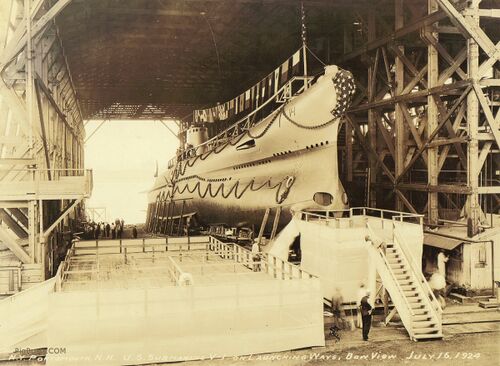
This is a good look of the bow torpedo tube outer doors. Unlike subsequent practice, they do not smoothly fare into the outer hull. The pressure hull was a complex of various angles and diameters bringing the torpedo tubes to the hull's lowest point. The hull was a variety of shapes from circular to ellipses, making the construction very difficult for the shipyard.
U.S. Navy photo

A large brace has been attached to the shaft struts and clamps together, over the top of the stern planes and aft of the rudder. This is to prevent damage to the rudder and stern planes as the submarine slides backwards into the water. Just above the rudder the two aft torpedo tubes can be seen.
U.S. Navy photo
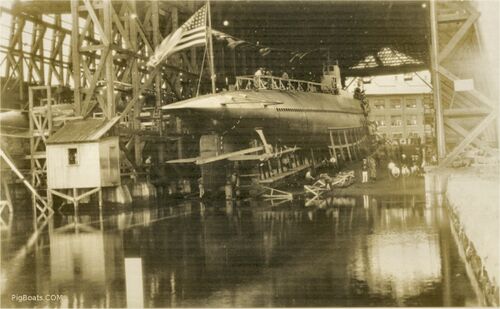
At the left in the photo, what is probably the V-2 sits on the ways. Just the slope of her stern, matching the V-1 stern, can be seen.
Photo in the private collection of Ric Hedman.
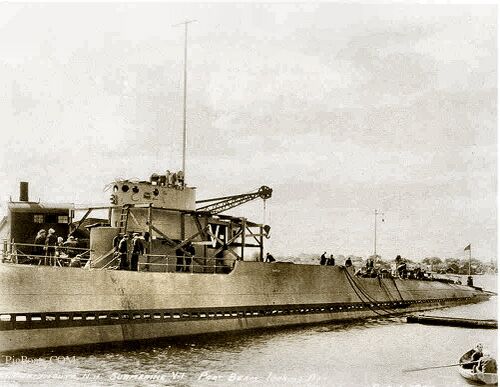
V-1 alongside the fitting out pier at the Portsmouth Navy Yard, Kittery, Maine. The date is late summer 1924 and there is still a lot of work to do to complete her construction phase and get her ready for sea trials. The big fleet boat dwarfed any submarine previously built at Portsmouth, presenting special challenges to the yard workers.
USN photo in the private collection of Ric Hedman.
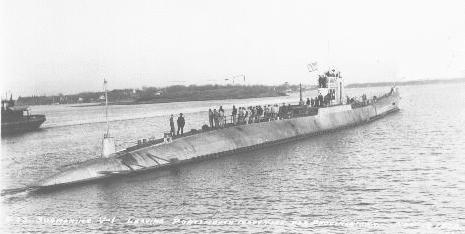
U.S. Navy photo

U.S. Navy photo

V-1 underway at a sedate pace in the Atlantic, likely during her initial sea trials in November, 1924. The location is likely between the New Hampshire coast and the Isle of Shoals, a frequent submarine operating area in those days. The authors have not been able to determine if the discoloration on her amidships and aft superstructure is corrosion related or is simply an artifact of the photograph. The two photographs above seem to indicate that the yard had not yet fully applied the required haze-gray paint scheme to the boat when she departed on trials, and this is not entirely unusual during this period.
At least 13 men are topside, and these would have been a combination of the sub's crew, and civilian yard workers aboard to test and observe the installed systems. Her heavy fore to aft mine clearance wires and long range aerial wires have not yet been installed. There is no smoke from the aft engines, indicating that she is running with them disengaged, powered by the forward generator engines or just running on the battery.
Photo USN 456143 courtesy of NHHC.
Operational service as V-1, 1924 to 1931
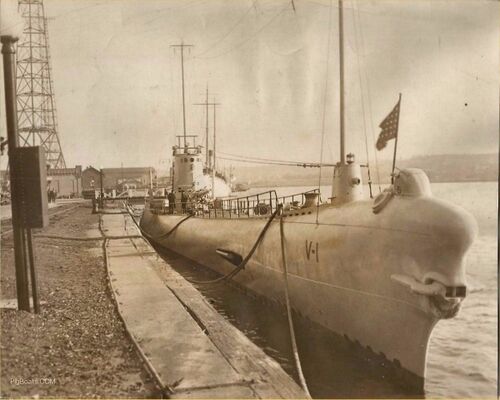
U.S. Navy photo

There is an unidentified yacht like ship in the background, possibly the Presidential yacht, Mayflower. The Mayflower had her small boats stowed on highly raised davits as seen in this photo and a clipper type bow as implied here. Detail is lacking for full conformation.
U.S. Navy photo
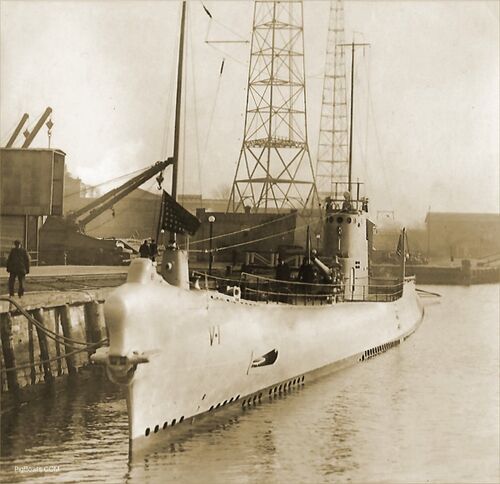
U.S. Navy photo

Photo courtesy of Ron Martini

All three of her radio masts are lowered, indicating that she has just surfaced or is preparing to dive, although either maneuver would be dangerous this close to land.
It was reported in The Evening Leader of Corning, NY on Feb 20, 1925 the following: "Faizalli Mahrshacca. 20. Lascar¹ fireman in the British steamer Luceric, which came into Norfolk, Va., recently, had been denied shore leave and was determined to land in America. So when the ship was passing Thimble Shoals he threw a keg overboard and jumped after it, clinging to it through the chilly dawn. The submarine B-1² was proceeding down the harbor and sighted the Lascar, still clinging to his keg. He was almost frozen, but he fought against rescue and was subdued by force. The submarine carried the man to Cape Henry and placed him aboard the pilot boat Relief, which hastened to overtake the Luceric, and put the man back aboard her as she passed through the Virginia Capes"
1. Lascar; A semi-derogatory term for a sailor or militiaman from the Indian subcontinent, Southeast Asia, the Arab world, British Somaliland or other lands east of the Cape of Good Hope who was employed on European ships from the 16th century until the mid-20th century.
2. Referring to this boat as B-1 was likely a simple typo at the time by the reporter. V-1's name was changed to Barracuda on February 19, 1931 and between then and late 1938 she coincidentally had the class identifier "B-1" painted on the side of her fairwater, but this was not the boat's name. It certainly was not being used in 1925 when the article was written. See this article for more information on this confusing issue.
National Archives photo
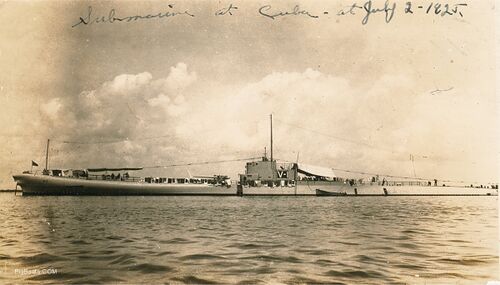
One of the two ship's boats, stowed under the deck just aft of the conning tower fairwater when not in use, can be seen moored alongside. Forward of the conning tower can be seen a folding set of steps to allow access to the submarine from a small boat. These were folded back into the superstructure when not needed.
Photo in the private collection of Ric Hedman.
It was reported on April 30, 1926 that the V-1, while under command of LCDR Sherwood Picking, struck a large whale while submerged off Cape Cod. The submarine was in the act of surfacing when a sudden jolt shook the submarine. Upon surfacing a 58 foot long whale was found to be bent around the bow of the submarine. The collision had apparently broken the whale's back and killed it. The sub suffered no damage. The whale was towed into Provincetown before being towed back to sea and allowed to sink.
International Newsreel photo in the private collection of Ric Hedman.

V-1 running with a "full head of steam" during engineering trials following an overhaul period, June 5, 1926. The location is the New England coast, either near the Isle of Shoals off the New Hampshire coast, or in Cape Cod Bay on the measured mile there. She is throwing up a substantial bow wake in the calm waters and her aft main propulsion engines are smoking considerably, meaning that they are under a heavy load. To get this speed she would also have to have her forward generator engines engaged and under load, producing extra electricity for the main motors. She is likely near her top speed of 21 knots, but it is known that the V-1 class boats struggled to achieve and maintain this high pace.
Her three radio masts (forward, fairwater, and aft) are fully raised with the long-line radio aerials strung between them. This enabled the sending and reception of messages at long range, an essential element of her mission as a scout for the fleet.
Photo NH 63175 courtesy of NHHC.
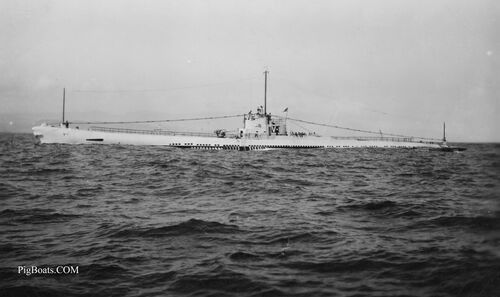
V-1 shown underway off an unknown location, possibly San Diego, 1925-1928. At the time of this photo, she still has her large 5"/51 caliber gun on the forward deck. This gun was removed in mid-1928 and replaced with a smaller 3"/50 caliber gun as a weight saving measure. The gun itself is trained out to port, indicating that they may have recently participated in a gunnery exercise. A number of the crew are lounging on the deck aft of the fairwater, atop the small boat stowage locker with their feet hanging over the boat boom crane. These boats still did not have air conditioning at this point, and thus were hot and stuffy below decks. The crew were afforded many opportunities to come topside in order to escape the sometimes fetid conditions below.
There is a slight roll to the seas, with the boat on top of one wave with water draining from the superstructure.
Photo in the private collection of Dave Johnston.
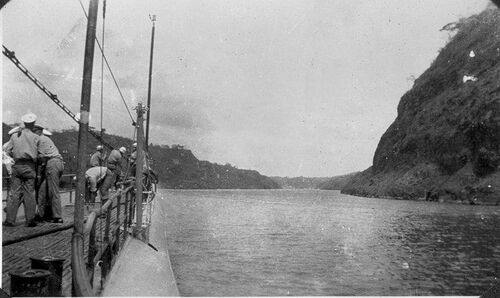
Photo in the private collection of Ric Hedman.
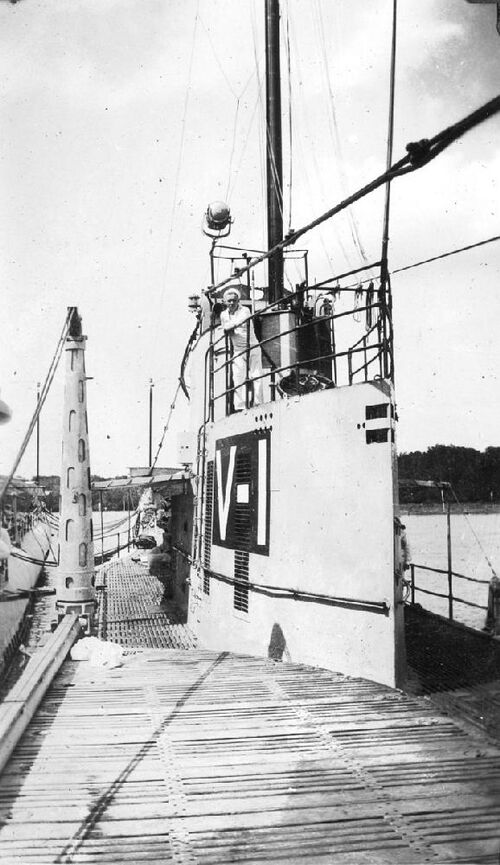
Photo in the private collection of Ric Hedman.

Photo in the private collection of Ric Hedman.
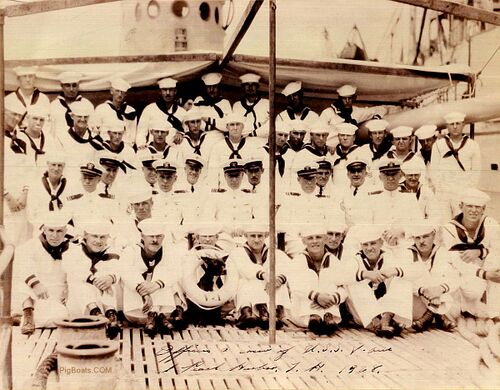
In the photo the fourth man from the left, second row from the top, is Herman S. 'Brigham' Young, grandfather of Johanna Young who submitted this photo.
The barrel of the V-1's 5"/51 caliber deck gun is pointed to the right in the photo to make room for all the men to be positioned at the widest point on the deck. The top man on the right is leaning on the barrel.
Original photo in the family collection of Johanna Young. MAY NOT BE REUSED OR REPOSTED WITHOUT PERMISSION.
Renaming and later service, 1931 to 1945
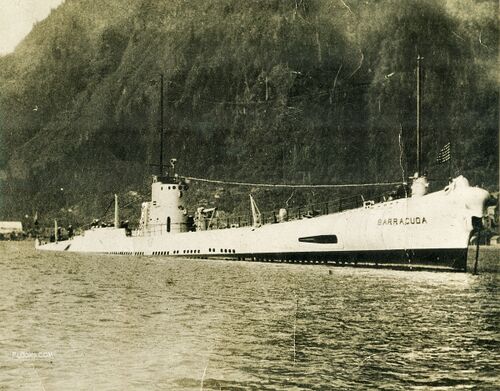
Photo in the private collection of Ric Hedman.

Photo in the private collection of Ric Hedman.
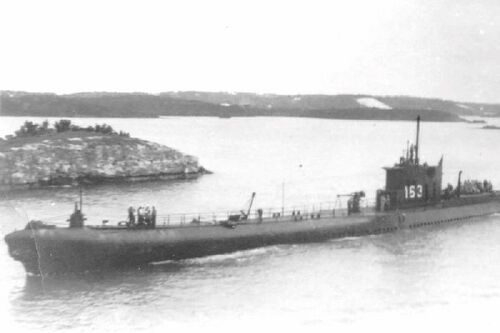
U.S. Navy photo
Page created by:
Ric Hedman & David Johnston
1999 - 2023 - PigBoats.COM©
Mountlake Terrace, WA, Norfolk, VA
webmaster at pigboats dot com

